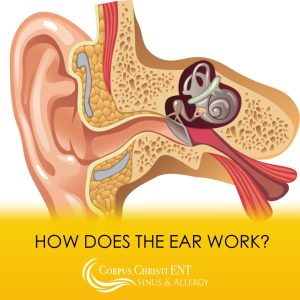
Let’s take a moment and have a very simple conversation about how the ear works. The ear structurally can be broken down into four parts: the outer ear, the middle ear, the inner ear, and the auditory nerve.
- The outer ear is composed of the pinna, the cartilage that we see on the sides of our heads, and the ear canal. It ends at the tympanic membrane or ear drum. The ear canal protects the ear drum from damage.
- The middle ear starts at the ear drum and contains the ossicles, the smallest bones of the human body. It is normally an air-filled cavity. There is a tube, the Eustachian tube, that connects the middle ear to the back of the nasal cavity. The purpose of the Eustachian tube is to ventilate the middle ear to maintain equal pressure on both sides of the ear drum so that it can vibrate easily.
- The ossicles push on the oval window, the entrance to the inner ear. As the window is pushed in, the fluid in the inner ear moves in waves. These waves cause little hair cells to move triggering nerve impulses.
- The nerve impulses travel through the auditory nervous system up to the brain where they are processed.
In function, we break the ear down into two sections, the conductive portion and the sensorineural portion.
- The conductive portion of the ear is made up of the outer and middle ears. The purpose of this section of the auditory system is to transmit, or conduct, sound to the sense organ for processing. The ear canal delivers the sound waves to the ear drum. Along the way, it also boosts a few of the higher pitched sounds in volume. The middle ear also boosts the volume of the sound waves. This is important. The inner ear is filled with fluid. When we move from an air-filled space to a fluid-filled space, we lose some energy. Think about how fast we can run on land versus how fast we can run in the water. There is a big difference. We need that boost in volume to offset what we lose when we transition to the inner ear. How these boosts occur is due to physics and quite fascinating.
- The sensorineural portion of the ear is made up of the inner ear and auditory nerve. The purpose of this section of the ear is to take the sound vibrations and convert them into something the nervous system will understand. It is in the inner ear that we break down sound into different pitches, recognize different loudnesses of pitch, and timing of sounds. This information is sent through the nerves up to the auditory cortex in the brain where it is finally processed and recognized, where we “hear” what was said.
A disruption in any portion of the auditory system can cause a hearing loss. If you think you are having trouble with your hearing, call and schedule an appointment for a hearing evaluation.